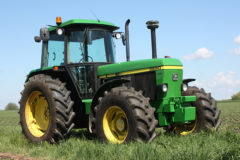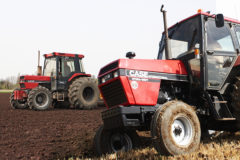An ideal first-time tractor
Posted by Chris Graham on 26th July 2020
The Fordson Dexta can make an ideal first-time tractor, and now could just be the perfect time to buy, as Chris Graham explains.

An ideal first-time tractor: The Fordson Dexta was available as a standard, a narrow and an industrial. This is a narrow version – with an under-swept exhaust – that spent its working life in Kentish fruit orchards. Note the headlamps in the radiator grilles, a feature of 1960-onward Dextas.
Ford’s decision to launch the Fordson Dexta back in the mid-1950s, was one largely driven by pressure from its marketing department. The salesmen out in the field understood the situation; they could see the potential for a smaller, lighter tractor model among UK farmers. But that sector of the agricultural market had been dominated – since the end of WW2 – by the Ferguson TE-20.
The arrival of the MF35 in 1956 hammered-home the threat posed by the ‘grey menace’, and Ford’s reaction was the timely introduction of a little brother for the already successful Fordson Major. The Dexta was unveiled at the 1957 Smithfield Show, and started getting out on to farms the following year.
The main snag in its evolution had concerned the engine, and the considerable in-house costs associated with developing a suitable new design for a ‘light’ application. Fortunately for Ford, an existing association with Peterborough-based engine builder, Perkins Limited, provided a reliable and money-saving solution.
Diminutive diesel
Ford had used the trusty, Perkins P6 diesel engine in both the E27N tractor and, on the commercial vehicle side, in the Ford Thames lorry. Perkins’ reputation for engineering excellence was well established, and the fact that it had recently added a three-cylinder, 32hp diesel unit – the P3 – to its range, seemed too good an opportunity to miss.
As for the rest of the new Dexta’s design, well, it essentially followed the format of the USA-only Fordson 8N model, albeit with a redesigned gearbox offering six forward ratios and two reverse. The potential was also introduced for a ‘live’ PTO, which would allow implements to continue being driven even when the tractor itself wasn’t moving.
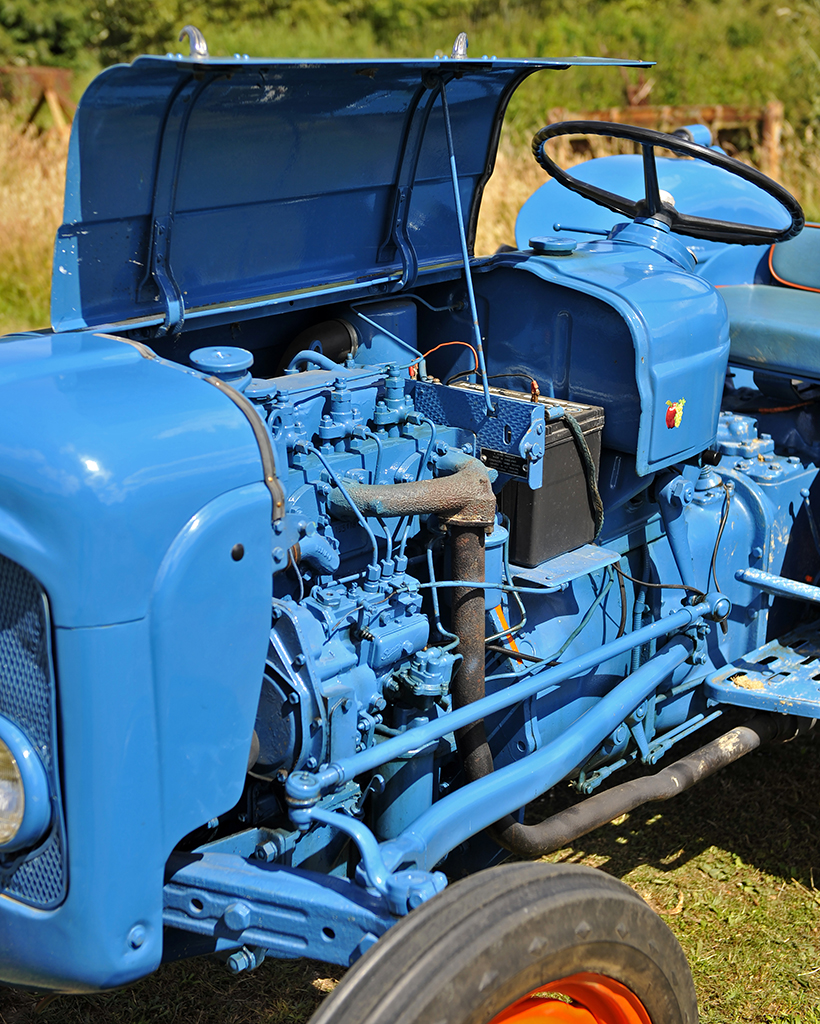
The Dexta relied primarily on Perkins diesel power, with the three-cylinder P3 engine like this being fitted to most models. A petrol version, that used a four-cylinder motor made by Standard, was produced primarily for export.
A much-improved hydraulic system was carried over from the 8N, too. The better pump and position control capability delivered genuine, practical advantages over previous systems, and allowed the use of implements designed for the larger, Fordson Major. The overall look for the new machine was greatly influenced by the E1A Major, and customers could opt for an under-swept or vertical exhaust. Many of the bolt-on ancillary components were sourced from established, British manufacturers of the time, such as AC (filters), Girling (brakes and Lucas (electrics).
Various models
Different versions of the Dexta were offered, including the Industrial, that was actually finished by County Commercial Cars Ltd, in Fleet, Hampshire, and featured extra lighting, a speedometer, extra mudguards, rear-view mirrors and hydraulic brakes. Narrow, ‘vineyard’ versions (52in at the rear wheels) were produced, too, and a four-wheel-drive model was developed by Roadless. There was a petrol version produced as well, powered by a four-cylinder Standard engine. This was 11cm longer than the diesel-powered versions, and was intended for export markets in Scandinavia, Australia and New Zealand.
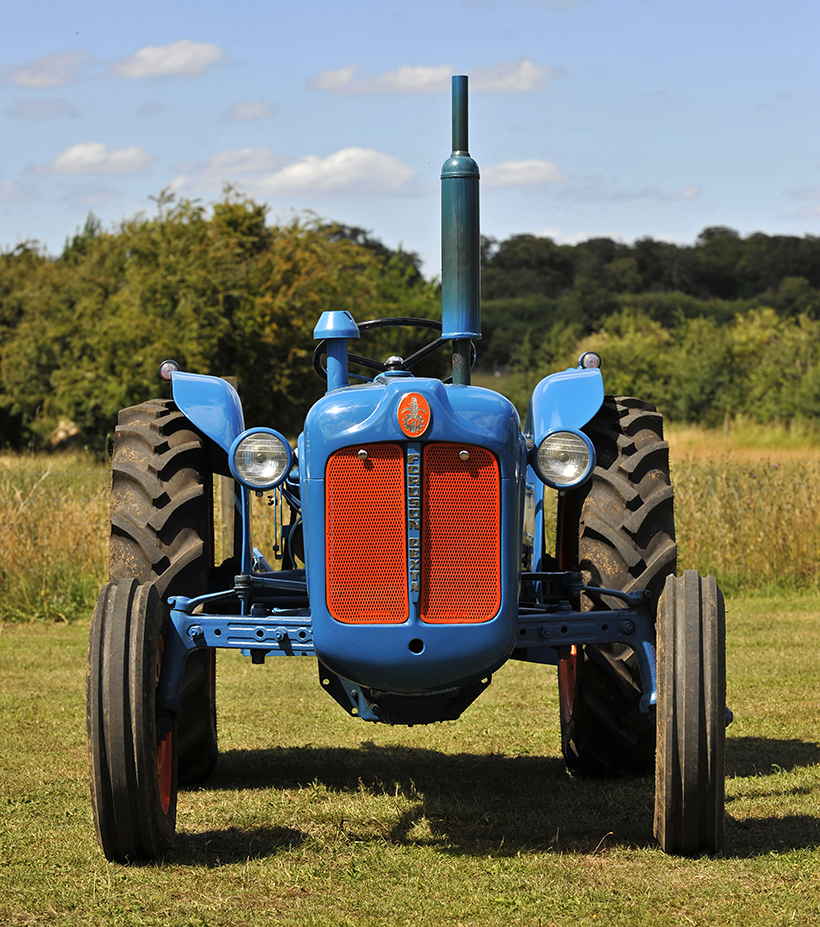
The earliest Dextas has headlight mounted on either side of the radiator cowl, the Fordson wheatsheaf badge and model name lettering vertically down the radiator grille divider. This model has the vertical exhaust, chosen when ‘headroom’ wasn’t an issue.
The arrival of the Super Major model in 1960 triggered a mild facelift for the Dexta, which saw its headlights re-located to within the radiator grille. But then, more significantly, the Super Dexta was launched, early in 1962. It came with engine improvements that boosted performance, and some cosmetic, bodywork and badging changes. A slight capacity increase, and the addition of a Simms Minimec fuel-injection system (replacing the original CAV DPA set-up), lifted the engine’s power output to 39.5hp.
Then, in the summer of 1963, the colour scheme of the standard Dexta was switched from the original Empire blue and orange combination, to blue and grey, and the background colour on the badging was changed from orange to grey. The final iteration of the model was the New Performance Super Dexta, which benefitted from an engine power output increase to 44.5hp (maximum revs increased from 2,200rpm to 2,450). However, this model only lasted in production for just over a year, and was replaced by the Basildon-built 3000 in September 1964.
Buying pointers
Nobody seems able to put a precise figure on how many Dextas were actually build by Ford, but I gather that Perkins supplied nearly 218,000 P3 engines to the Dagenham factory between 1957 and ’64. So, I think it’s fair to conclude that the Dexta was a very successful and popular tractor model in its day and, as a consequence, plenty have survived the intervening 60-or-so years.

The Dexta featured a brand new gearbox, with six forward gears and two reverse. Gear selection can be an issue with worn/abused transmissions. Never use modern transmission fluid.
Getting hold of a Fordson Dexta today isn’t difficult; there are plenty for sale in classified listings and online. However, condition will vary enormously, and would-be buyers should be aware of the problems that can lie beneath the surface. To discover more about this, I consulted experienced Dexta owner, Tony Wyslocky, who currently owns 19 tractors and has restored a couple of his own Dextas.
The first point that Tony made was that buyers should always be cautious about ‘restored’ examples, as that term can cover a multitude of sins. At one end of the scale, a tractor may have been expertly re-built by a knowledgeable and experienced specialist while, on the other, the ‘restoration’ may have extended to little more than a badly-executed paint job.
“There’s an increasing tendency towards over-restoration these days, but I don’t mind either way. I’ve fully restored some of mine, but also left others in much more original looking condition,” Tony told me. “Such treatment can gloss-over all sorts of short-comings beneath the surface, which is why I prefer to buy tractors that are in original, un-restored condition; then you can see properly what you’re getting.
“Having discovered what you can about a tractor’s history, I always start any inspection with the engine. Have it started – preferably from cold – and look and listen carefully as the engine warms. Poor-starting, rattly or excessively smokey engines should set the alarm bells ringing. Notice what comes out of the exhaust pipe. A bit of smoke on start-up is perfectly acceptable, but this should reduce to nothing once the engine is warm.”
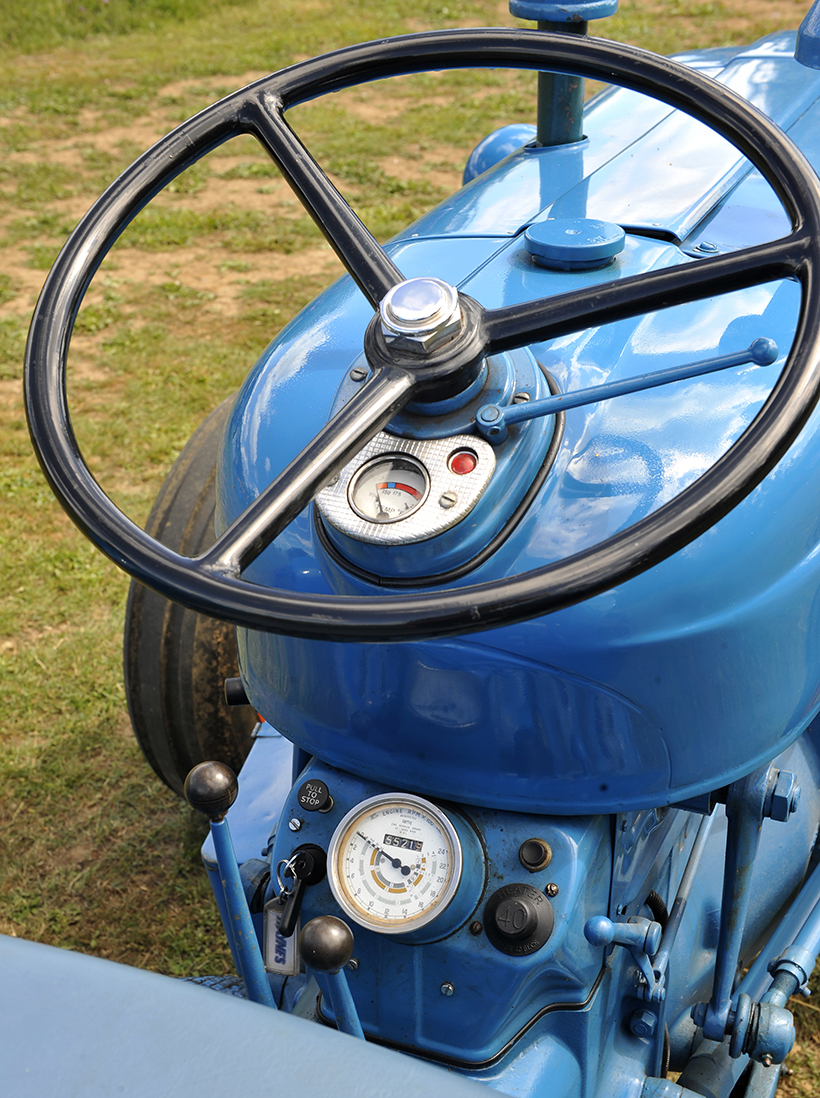
Controls and instrumentation are simple and essentially reliable. The dial just below the steering wheel boss shows water temperature, and is flanked by warning lights for generator charging (left) and oil pressure. The lower panel contains the ‘proof meter’ in the centre (displaying engine revs, an approximation of speed in each gear and a counter for the hours run) and, arranged around it, a horn button (top right), induction heater button (bottom right), main control switch/ignition/lights (bottom left) and an engine stop control (top left).
Smoking signs
“If there’s anything more than a puff of black smoke when the engine is revved, then be warned. White smoke in the exhaust tends to indicate fuel-related issues (pump problems), while blue smoke points towards oil-related trouble and internal, mechanical wear. Other useful checks to make include removing the dipstick and oil filler cover, with engine speed set at about 1,500rpm. If there’s any sign of fumes or oil being blown out, things aren’t good inside, and you’d be best advised to walk away, unless you’re looking at an especially desirable model.
“Listen to the noises the engine makes, too. Any internal rattles or knocking you detect could be indicators of worn tappets or bearings, and trouble ahead.” Overall, though, the Perkins P3 is a rugged, well-designed unit that will happily run and run assuming it’s given an appropriate level of TLC. It’s still possible to find the sweetest-running engines in the most down-at-heel-looking examples, so never write-off a potential purchase on looks alone.
While a P3 engine rebuild isn’t a massively technical job, paying a specialist to do it is likely to result in a largish bill. Rebuild kits are available for £300-£400, but it’s the hours involved in doing the work that can send the price rocketing. Also, it’s important to appreciate that if the engine is clapped-out, then the chances are that the rest of the tractor will be, too. So, as well as an engine rebuild, attention to the clutch, braking system, fuel injectors and pump will also have to be budgeted for.

The Super Dexta arrived early in 1962, with engine improvements that boosted performance, and some cosmetic, bodywork and badging changes. This model has been lowered by the fitting of smaller rear wheels; it was used for greenhouse work.
Despite the legendary durability of the Perkins P3 diesel engine, abuse and/or mechanical neglect can bring one to its knees sooner than you might imagine. A common – and often costly – mistake is the use of the wrong type of oil. Those new to the hobby can imagine that filling the engine with a modern, high-tech semi-synthetic or synthetic engine oil is a good thing to do.
Dangerous additives
The reality is that the detergent additives in modern oils can wreak havoc inside a 60-year-old motor, stripping away vital, top-end lubrication. Instead, a good quality mineral oil should always be specified; the same applies to the rear axle and gearbox.
As always, you’ll need to road-test a prospective purchase, or have somebody experienced do the job for you. While the six-speed transmission is a generally reliable and durable unit, Tony says that there can be gear selection issues.
“A worn selector mechanism can leave the gear lever feeling very sloppy and vague to use. It seems that there was a bit of a weakness with this aspect, and heavy-handed use of the gear lever can cause the gearbox to jam completely, stalling the tractor. This is obviously more likely with a worn unit, but have heard tales of it happening on new machines, too.
“There’s a spring-loaded ball bearing at the base of the gear lever and, under normal circumstances, you’ll be able to hear a distinct clicking as each gear is correctly selected. But, with a combination of age and abuse, the spring can lose its effectiveness and the ball bearing may even fall away and, with it, goes the clicking sound. So, if you can’t hear that as the gears are selected – and there’s excessive play in the lever – then there are problems inside the ‘box.
“If the gearbox locks due to bad gear selection, stop the tractor, undo the four 13mm bolts, remove the cover plate and the levers, centralise the two selectors with a screwdriver, then replace the plate with the gears in neutral and re-tighten the bolts. Replacing worn selectors is a big job that involves splitting the tractor and stripping the gearbox. The spares are virtually impossible to find new, so will more than likely have to come from a donor tractor.”
Rear-axle issues
The one other ‘big’ internal problem to be aware of, Tony told me, relates to the rear axle. However, it can only really be identified with the tractor running down an incline with the transmission lightly loaded. “It’s a bearing-related problem,” Tony explained, “which, for some reason, you can’t hear with the tractor running on the flat or up hill – I think it relates to loading on the system.
“If there’s wear in the system, you’ll hear a distinct rumbling from the back on a downhill stretch, and putting this right can be expensive. The parts are very difficult to find nowadays and, often, the simplest option is to replace the whole rear axle assembly, with one from another, donor tractor. On the plus side, though, the discovery of such a problem will provide a good bargaining point, regarding the selling price.”
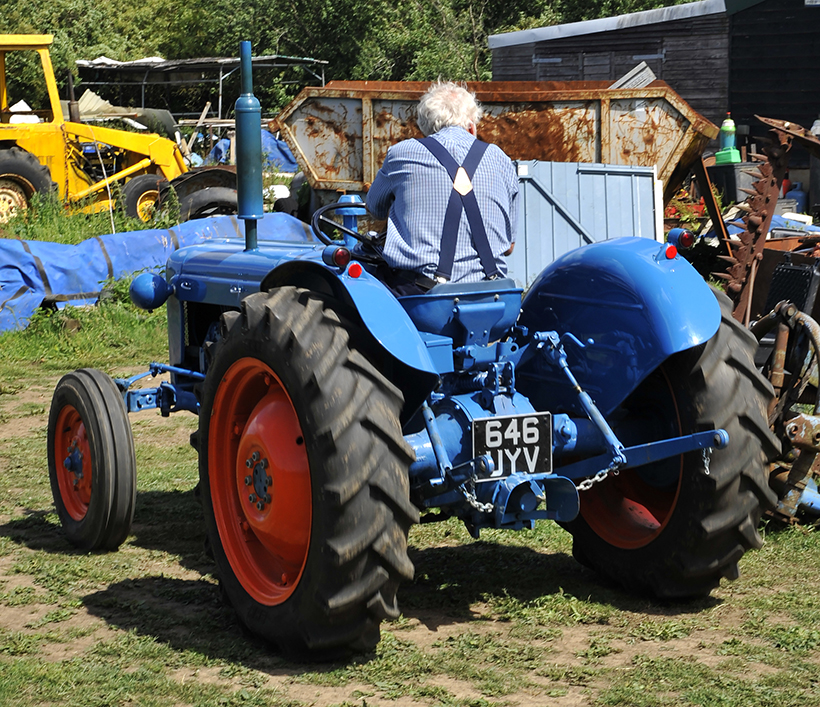
One of the beauties of the Dexta is its manageable size; it makes a great first tractor for those new to the hobby.
Elsewhere, there are usually few other nasties to check for on a Dexta. The drum-based brakes are generally OK, and don’t usually cause much trouble. When operating properly, they’re reasonably effective, and were certainly adequate for a tractor of this size and weight. The electrics are similarly simple and reliable and, as far as the tinwork is concerned, much depends on how the tractor has been used and stored. Rust can be found in all the usual places (footplate, wings etc), and nose cones often take a bit of a battering.
Overall, then, the Fordson Dexta has a lot going for it. As you’ll see from the ‘What to pay’ panel, one could be yours at an affordable price, and the tractor itself represents an excellent first-timer’s machine. The Dexta delivers an appealing mix of ‘old school’ charm and looks, combined with the convenience of an electric start, manageable size and perfectly usable performance. At its core, it’s a tractor that’s easy to drive and straightforward to live with and maintain on a DIY basis. What’s not to like?
WHAT TO PAY
Entry-level for the Dexta lies somewhere between £600 and £1,000. Tractors at this end of the price scale might have a running engine, but will certainly require some – probably significant – expenditure to bring it up to scratch. But bargains are still out there.
A fully-restored Dexta can sell for £5,000-£6,000, but the quality of restoration can vary enormously. If you’re after a middle-of-the-road, usable example in decent, running order, you should expect to pay £2,000-£3,000. The rare, Roadless 4WD version is perhaps the most desirable and sought-after Dexta today; one of these can fetch £20,000 at auction.
FORDSON DEXTA SPECIFICATIONS
| Production period | 1958-1964 |
| Produced at | Dagenham, Essex |
| Engine: Standard | Diesel, 3-cyl, 2,360cc, 37hp |
| Export model | Petrol, 4-cyl, 2,203cc, 37hp |
| Super Dexta | Diesel, 3-cyl, 2,500cc, 39.5hp |
| New Performance Super Dexta | Diesel, 3-cyl, 2,500cc, 44.5hp |
| Paint colours | Empire blue/orange, Launch-1963 |
| Blue/grey, June 1963-onwards | |
| Dimensions | Length 118.5in
Width 52-89.2in Wheelbase 73.5in |
| Height | 54in |
| Weight | 3,075lb (1,396kg) |
For a money-saving subscription to Ford & Fordson Tractors magazine, simply click here



